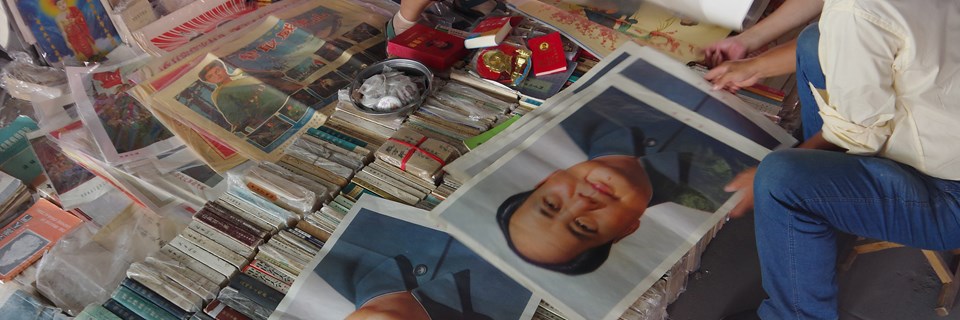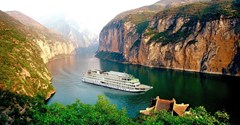Travel through the layers of fascinating history and culture and get to know the people of Beijing in true Veloso Tours style.
There is no better place to begin exploring the complex past and the juxtaposition of capitalism and communism in modern day China than its capital. Beijing is a multi-layered city of glorious temples dedicated to ancient philosophies, majestic palaces from the Imperial age, timeless Hutong side streets and a surprising array of contemporary bars, restaurants, hotels and art galleries, which express a more dynamic and creative side to the city. Just outside of Beijing are several places to walk along the Great Wall of China, ranging from those areas restored to their former glory to those left to the elements, where the true wild raw beauty of the Wall can be best felt.
Let's have a look at seven ways to experience the Chinese capital, with a selection of the best things to do and see in Beijing, to better understand its place at the centre of China's past and present.
Sign up for our 'China in a Week' service - seven easily digestible emails to help plan your trip through the People's Republic
1. Explore China's ancient roots in grand temples
By stepping into the hallowed and peaceful grounds of the Confucius Temple, you will not only be getting well off the typical tourist trail, but will also be metaphorically transported back 2,500 years to a very different China. Much of Confucius' lifetime (551-479BC) was spent trying to spread his now established Ru thought, based on mutually-respectful family and societal relationships within an ordered and clearly defined hierarchy, as well as the importance of continued education and self-improvement. Although today, and throughout much of history, these ideas form the pillars of Chinese society, his principles did not find favour with a ruling dynasty until after his death, during the Warring States period. The temple is a wonderful place to begin exploring his life, the profound impact he has had on China and the repression of his ideas in Mao's communist government. His philosophies formed the basis of Chinese state education until 1912, with exams on his thought for those who wanted to gain a high ranking government position.
Combine Beijing's temples with Tibet & Mount Everest
Taoism is another ancient philosophy, which has existed alongside (rather than in competition with) Confucianism for centuries. It is a complex and often abstract system of beliefs, based on the concepts of Yin and Yang; keeping a natural order and healthy balance in one's life and the importance of inner strength and trusting one's intuition. The Dongyue Taoist Temple is noted for its 76 departments of the Taoist supernatural world. Some are unnervingly grousome warnings of the consequences of misdemeanours, others to which you can pray for happiness, wealth, longevity or, most intriguingly, revenge.
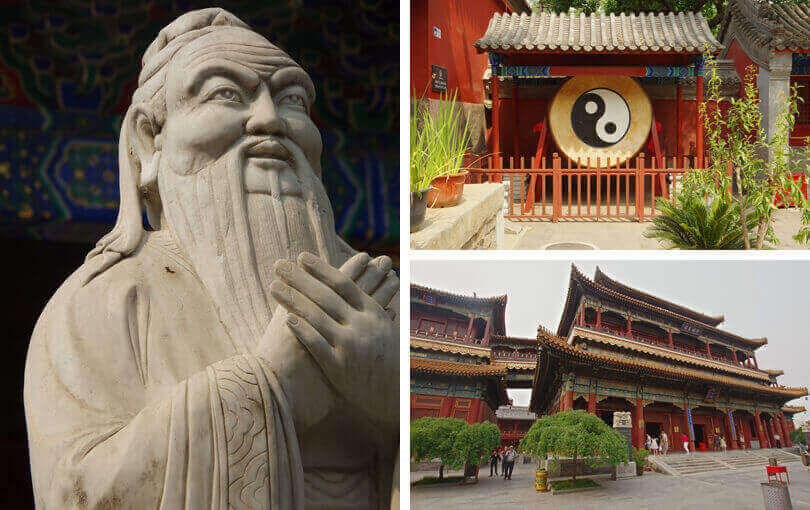 Confucius, Yin & Yang at Dongyue Temple & Lama Buddhist Temple
Confucius, Yin & Yang at Dongyue Temple & Lama Buddhist Temple
Buddhism first emerged in China during the Han dynasty, around 65AD. It grew in popularity during the ensuing centuries, leading to the establishment of early Buddhist cave complexes, including at Datong near Beijing, full of ancient art and cultural relics. Buddhism was then banned as part of the 9th century Tang dynasty's attack on "outside influences" and then again suppressed my Mao in the uncompromising Cultural Revolution of 1965. However, the religion is thriving again, with an estimated 400 million Buddhists in China, including the president's wife and daughter. Situated near the Confucius Temple north of the Forbidden City, the 17th century Lama Buddhist Temple is one of the largest and most impressive of China's lamaseries outside of Tibet. Incence-filled rooms, richly decorated halls and polished Buddha statues will transport you to the holy land, in the company of worshipping Beijing's, young and old. The highlight of the temple is perhaps the 17 metre high statue of Future Buddha, carved out of a single block of sandalwood.
2. Delve into Beijing's lively hutongs
The grey rooftops of Beijing's Hutong alleyways once dominated the centre, radiating outwards from the Forbidden City, whose yellow-tiled rooftops were reserved for royalty. Although huge swathes have been torn down, many substantial pockets still exist, some finding second lives as family restaurants, bars and shops. Thankfully, the rate of destruction has slowed, but the younger generation are moving out to apartment blocks on the edges of the city, threatening their future.
What the new flats lack in character and prime location, they make up for in comfy, space, communal facilities and, most notably, private bathrooms. However, many older Beijing's still faithfully reside here in small single-story homes laid out in sets of four, facing inner courtyards in the most traditional Chinese style. The outer streets are a hive of activity, with locals gathering to socialise, play Chinese chess or whizz about on the famous army of Beijing bicycles.
Undertake cultural activities on a Beijing & Hong Kong twin-city break
A tour here can be taken on foot and on a pedalled rickshaw, stopping to perhaps meet a local family for some tea or lunch, take a calligraphy lesson or try your hand at making some authentic local food. There are few better places to get a glimpse into a traditional, yet disappearing, way of life.
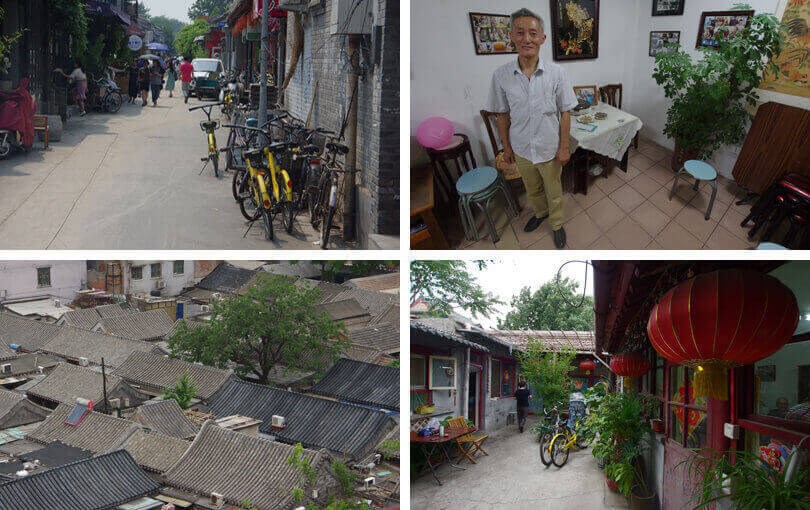
3. Relive the Imperial age at Beijing's headline acts
Beijing's 'big three' sights, which dominate the agendas of most tour operators, are the Forbidden City, the Summer Palace and the Temple off Heaven. As you can see from this list, they represent one part of a more complex city and culture, but perhaps the most important. With the right guide and an inquisitive nature, you will be able to piece together what life would have been like here during the centuries of dynastic rule by the all-powerful emperors. In Beijing alone there are more than 500 years of history to explore!
Situated in the very heart of Beijing, the Forbidden City was home to 24 Ming and Qing emperors, who ruled from this medieval royal complex. On a guided walk through the Forbidden City you will encounter magnificent halls and gates, elaborately decorated in the traditional style and ingeniously designed to withstand earthquakes, despite the structures being made only from wood. Intricate statues, bronze cauldrons and marble bridges provide focal points in the large courtyards. In total there were 9,999 rooms in the Forbidden City, nine being an auspicious number in architecture.
 Clockwise from top: Forbidden City, Temple of Heaven, Summer Palace, old Summer Palace ruins
Clockwise from top: Forbidden City, Temple of Heaven, Summer Palace, old Summer Palace ruins
Following the central axis of Beijing southwards will bring us, and in imperial times, the emperor, to the sacred Temple of Heaven. Although not strictly used as such, it is one of the largest, most impressive and most significant temple complexes in China. In the age of the dynasties, the emperor would arrive here amid much pomp and ceremony on the winter solstice to pray and make sacrifices for a bountiful harvest. In this way, the emperor was performing his duty as the conduit between heaven and earth and reinforcing his almost god-like status.
The focal point of the Temple of Heaven is the Hall of Good Harvest, were said act would take place. Encircled by an ornate maybe staircase, the temple is a triumph of precision engineering and classic beauty. Like the halls of the Forbidden City, it was constructed from wood and slotted together without a single nail and has a beautiful ceiling supported by 28 decorative pillars. The circular form represents heaven, whilst the square upon which it sits is a symbol of earth. There are few better examples of classic Chinese architectural principles, cosmic harmony and extraordinary ingenuity.
Marvel at Beijing's Imperial treasures and see pandas and the Terracotta Army up close
The sumptuous Summer Palace in the north of Beijing provided ample space for the Royals in which to relax and entertain guests amid landscaped parkland. The site is dominated by the man-made Kunming Lake, affording wonderful views across the water to architectural highlights, including the pagoda on Longevity Hill, the camel-back Jade Bridge and the Seventeen-Arch Bridge. The most impressive section of the Summer Palace is the extraordinary 728 metre Long Corridor walkway, intricately adorned throughout with some 14,000 paintings depicting classic Chinese scenes.
4. Observe early morning gatherings in the parks
As you have just read, the Temple of Heaven and the Summer Palace are two of the imperial age jewels that should be high on your agenda when coming to Beijing. However, where possible we would recommend visiting them on separate days, not just to allow a greater variety of sightseeing on any one day, or even because they are at opposite ends of the city. Instead, it is because both now reside within large public parks, which brim with older generation Beijingers from around 8am each morning, come rain or shine, in the cold of winter or the heat of the summer.
The sight of hundreds of retired Beijingers gathering to exercise and socialise is a true pleasure and one of the abiding memories many take away with them from China. The majority make use of the public equipment, some break off into smaller groups to practice Tai Chi or to dance in pairs, whilst others play jianzi (a game of keeps-uppy with a shuttlecock-like object). Elsewhere, older men bring their pet birds out for a 'walk', hanging their cages on branches of the trees as they converse with friends, allowing their companions some fresh air and company. Others use long paintbrushes to write Chinese poetry on the stone floor in water, eventually fading away again. In this way they are able to practice a beloved past-time, stay active, socialise with friends and not waste paper.
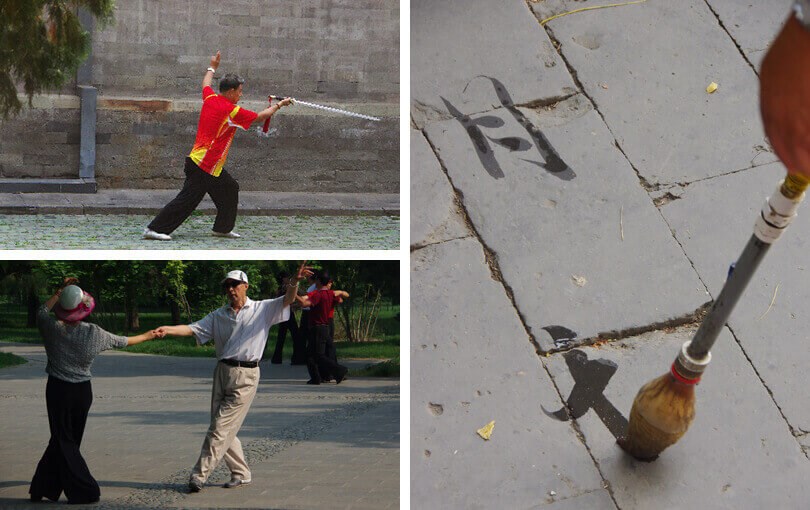
One of the more bizarre gatherings sees locals sitting together to play the erhu instrument from the world-famous Peking Opera. What makes it a rather endearing spectacle is that each plays their own sheet of music, all at the same time and each with no regard for harmony or co-ordination. The important thing is not the quality of the combined output, but rather a sense of community. In the Summer Palace there is more co-ordination on show, as locals attend a communal sing-along of 'red' Mao-era songs. It is not a closed group - anyone with the right book and a set of lungs can join in.
Watch the locals in Beijing and cruise along the Yangtze River
The gatherings provide a true insight into an important aspect of Chinese society; the elders of Beijing are an active, sociable and hardy generation, appreciated by the wider society and facilitated at every turn to enjoy their well-earned retirement.
5. Barter for souvenirs at the Antiques Market
There is a place in Beijing where Confucius and Mao stand side-by-side, alongside warriors from the Terracotta Army and quintessential symbols of Chinese identity like dragons and lions. These two giants of Chinese history, who lived thousands of years apart, promoted very different ideas about how society should be structured, principles which so spectacularly clashed during Mao's rule. But now they stand peacefully in statue form, waiting to be snapped up by rich locals or businesses at the Panjiyuan Antiques Market in the south of the city.
At weekends this otherwise nondescript area is transformed into a treasure trove of Chinese cultural relics and artwork, the vast majority of which are shining examples of China's commitment to and mastering of the industry of replication - telling the real from the fake usually requires the keenest of eyes and no small amount of expertise.

Whether you come to barter for gifts or souvenirs, to find your own copy of Mao's infamous little red book of communist thought or just to enjoy the sights and sounds of Beijing's best market, Panjiayuan is a wonderful way to integrate yourself with locals. It is also where you can learn about the Beijingers' curious fascination with collectable walnuts (yes that's right, walnuts) and pause for a drink to reflect upon the market and maybe your morning visit to the nearby Temple of Heaven.
6. Experience Beijing's creative side
If there is one place to go in Beijing to dispel the outdated myth of the Chinese as a cold, ordered and disciplined mass, it is without doubt the 798 Art District. Beijing's answer to Brooklyn or Shoreditch is colourful, creative, edgy, irreverent, daring and sometimes downright bizarre. Laid-back restaurants intermingle with contemporary shops in a minimalist style, whilst former communist era factories have been gutted and repurposed as hip art galleries, in what must rank as the best embodiment of 21st century China moving away from the past and embracing a more open and outward-looking future.
The 798 Art District combines well with a morning tour of the Summer Palace and a stop en-route at the Olympic Park to see another symbol of modern China; the Bird's Nest Stadium in which China announced itself to the world as an open society and in which Usain Bolt announced himself to the world as the greatest athlete on the planet.
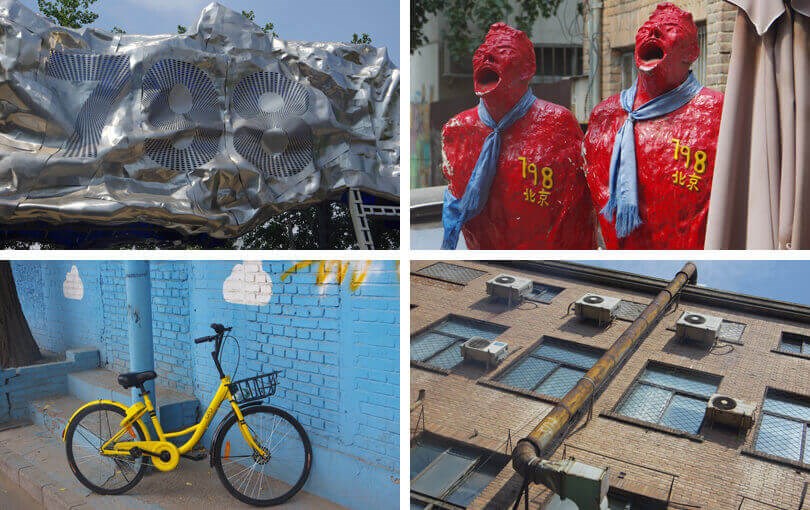
7. Hike along a wild section of the Great Wall
Our final entry on the best things to do in Beijing actually takes us about two hours north of the city, on a memorable day trip to walk along the fabled Great Wall of China. There are several places to access the Wall, meaning that you don't have to go to the same bit as everyone else if you have the right guide, a sense of adventure and a good pair of walking boots.
The most well-known and easiest to reach restored section is Badaling. As a consequence it is generally crowded and over-commercialised, offering precious little of the true essence of the Wall. Mutianyu is another popular restored section, with slightly less visitors and more space in which to walk away from the biggest crowds near the cable car sections.
Hike the Great Wall & go behind the scenes in beautiful Yunnan province
Other sections offer hikes along overgrown, unrestored sections, often in complete isolation. It is here that one is able to best experience the true majesty, scale, raw beauty and imposing nature of the Great Wall, immersed in nature and glorious silence. Ruined watchtowers hint at former glory, whilst views across the rolling mountains abound, with several sightings of crumbling and off-limit parts of the original structure. The going can be a little tricky in places for unexperienced hikers, but the views and the isolation make it well worth it.
In our view, the best solution is to undertake a 6km hike from the wild section at Xizhazi through to the restored part at Mutianyu, giving you a look at the Wall in both its overgrown state and a section restored to its original form, before taking the cable cars down.
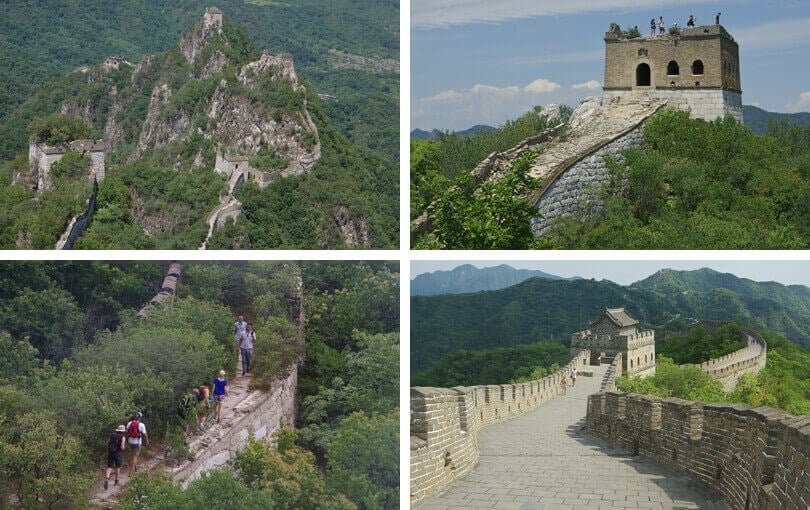
If you have been inspired to visit Beijing and undertake the activities above, all of which could be enjoyed across a four or five night stay, then we would love to discuss your options and put together a proposal for you. We firmly believe that, if experienced with the right ethos and guides, Beijing can set the scene for the rest of your travels better than any other city in China. Get in touch at china@veloso.com or give us a call!
Choose your perfect holiday
Find inspiration from our selection of itinerary suggestions, a great starting point for your next trip
View More Tours
Stay in touch
Infuse your travels, with inspiration from our monthly newsletter.
READY - 20 April 2024
LANDMARK TOURS: Multi-Country & Cross Continent. New Cosmopolitan Tour: Buenos Aires, Iguazu, Rio
CHINA & INDIA: Local Life, People & Unique Cultures
GUIDES by Veloso Tours, are the best Local Hosts
PRIVATE VILLAS: Quality Time in exclusive settings
TRAVEL INSURANCE with extensive COVID-19 cover
